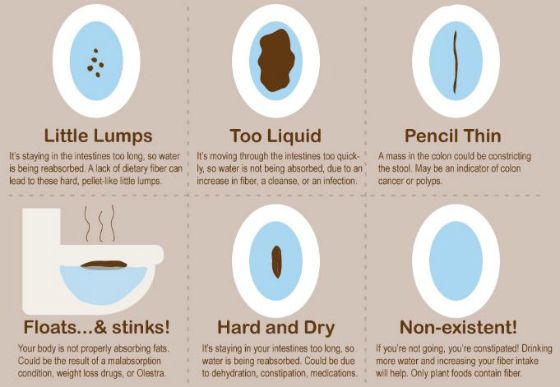
Talking about body waste is surely not the most pleasant topic to discuss but last week I did just that by sharing about what urine can tell one about their health. If we are discussing number one, surely we must consider number two. With that being said, today’s health focus is bowel movements or if you will the scoop on poop.
Like urine, bowel movements are an important mechanism for removing toxins from the body. The colon serves as a holding tank for waste matter. Scientific and medical research has shown that a proper balance between intestinal bacteria is key to long-term health.
People can have bowel movements as infrequently as three times a week but many health practitioners maintain that it is important to have a bowel movement every day at least twice a day. It is worth taking the time to look at the bowel movement results before you flush. The following chart provides guidance to what is normal, consider shape, size, smell and shade.

The Bowel Movement:
- It has to travel through about 30 feet of intestinal tract/colon
- A healthy bowel should look like a torpedo, be easy to pass and should sink to the bottom of the bowl.
- The average person will produce 9,000 pounds of poop over the course of his/her life.
- Artificial sweeteners aren’t absorbed by our bodies, so they pull water into the intestines…leading to loose stools.
Normal poop can come in a range of colors (influenced by what you eat and what medications you taken among other factors). If your stool has a unhealthy hue, particularly if it ‘s pale or grayish in tone, you could shave problems somewhere along your gastrointestinal tract (GI). The liver excretes bile to help break down fats in the food you eat, and that bile also adds color to the stool. But if there’s a blockage in the liver–or in the tubes where the bile travels–the stool might take on a too-pale appearance. Also, if you suffering from a pancreatic disorder, the stool might look gray or white because it is lacking the color imbued by the digestive enzymes produced in that organ.
Color of Stool:
- Red: Lower GI bleeding or eating red beets
- Green: Undigested bile, Crohn’s Disease, taking high dose of antibiotics, leafy greens
- Yellow: Gallbadder problems and Giardia (parasite)
- White: Antacids, liver disease and pancreatic disorder
- Black: Upper GI bleeding, meat and iron supplements
According the Healthy Living, those ideal torpedo-like bowel movements should sink when they hit the toilet. But when the body isn’t properly absorbing fat from the food you eat, it ends up being secreted in your stool. The result: stool that’s yellowish in color, greasy in consistency, foul smelling, and floats in the toilet. Certain medical conditions, like celiac disease, can cause malabsorption problems. And since essential nutrients could also be lost along with un-absorbed fat, it’s important to see your doctor if you experience this problem. These fatty, smelly stools are also one of the more unpleasant side effects of eating foods that contain Olestra (the faux fat found in chips and other fried snacks) or of taking the weight loss drug Xenical or it’s over-the-counter cousin, Alli.
From my research in writing this article, eating high-fiber foods such as fresh fruits, raw green leafy vegetables, whole-grain oatmeal and brown rice are a daily must. Dietary fiber is not only good for bowel movement but also promotes a shift in the gut toward different types of beneficial bacteria and protects gastrointestinal health according to a study by University of Illinois.
Drink more water. This is important when adding fiber to your diet. Drink ten 8-ounce glasses of water every day, whether you are thirsty or not. As we age, one becomes less able to detect true thirst. You can also try the recipe for Sassy Water as mentioned here. I like the following suggestions about the best time to drink water:

Of course knowing that our diet plays a key role in our health, the diagram below gives great food suggestions to help with elimination while cleansing our colon:

Well, I hope this week’s scoop on poop helps to provide some valuable insight into what may provide important clues to your health. I am done for now being Up Close and Personal. Thanks for stopping by, I appreciate it.

Eugenia! Continue to keep us informed holistically! Being proactive about our health and bodily functions is key! Good information as usual!
April, yes, this one was interesting post but needed to be shared because of the important tips one can learn about elimination from our bodies.